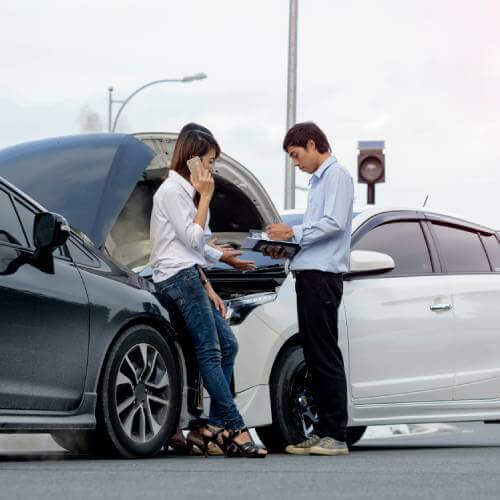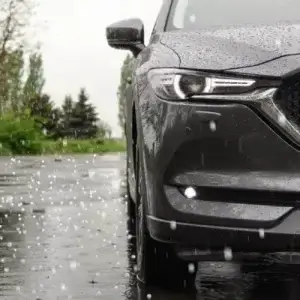Home / Compare Car Insurance / Car insurance write-offs
Car insurance write-offs



Key takeaways
- A car might be written off if it’s too expensive or impractical to repair after an accident or other damage.
- There are two types of vehicle write-offs: statutory and repairable.
- Comprehensive car insurance could cover your vehicle for an insurance payout or replacement if it’s written off.
Expert tips on car insurance write-offs
Our resident car insurance expert, Adrian Taylor, has helpful tips for dealing with car insurance write-offs.

You may be eligible for a new car replacement
Some insurers offer new car replacement if your new car is a total loss and written-off within a set time frame. You have to be the first registered owner and this option typically only lasts one or two years or up to a specified number of kilometres. Be sure to read your PDS to understand how new car replacement works in your policy.
Consider getting an agreed value in your policy
If you’re looking for peace of mind knowing what you will receive if your car is written off, it’s worth considering an agreed value car insurance policy. You should contact your insurer to find out if this option is available to you.
Inform your insurer of any modifications to your vehicle
You should let the insurer know if you’ve made any modifications to your vehicle, even if you don’t want these to be covered. That said, doing so can also help to ensure you’re covered for the cost of the car and your modifications if your car is written off, depending on the terms of your policy.
The basics
What is a write off?
A write-off (or a total loss) is when your car is damaged so severely that your insurer considers it too expensive or impractical to repair. Our survey data reveals that 18.2% of motor vehicles in collisions are written off.1
Even if the damaged vehicle looks okay following an incident, it could still be a write-off if there are serious unseen issues (e.g. damage to the chassis or similar structural damage).
Certain thresholds have to be met for a car to be considered a total loss and written off, which are laid out in the written-off vehicle register (WOVR).
How is damage assessed on vehicles?
 The assessor will analyse the damage based on standardised damage assessment criteria and categorise it based on:
The assessor will analyse the damage based on standardised damage assessment criteria and categorise it based on:
- The incident
- Damaged areas of the car
- The type of damage and the severity.
Once the vehicle inspection is complete, the assessor determines if it’s a statutory write-off or repairable write-off. This assessment will consider:
- The current market value or agreed value of the vehicle
- The cost of replacing exterior body parts
- Other expenses involved in repairing the vehicle.
What’s the difference between WOVR and PPSR?
The Written-off Vehicle Register (WOVR) is a directory that lists cars deemed a total loss by state and territory governments. The Personal Property Securities Register (PPSR) is a database that helps car buyers find out if a used car has a security interest against it.
A PPSR check can include information on whether a car is written off, which is information supplied by the WOVR.
Statutory write-offs vs repairable write-offs
Statutory write-off
Statutory write-offs are considered unsafe to repair. They can never be driven or registered again in some states and territories and may be reduced to scrap metal or spare parts. Check your state or territory’s WOVR restrictions for further details.
Repairable write-off
A repairable write-off is when the cost of repairs is higher than the sum insured, but can be repaired. In this instance, if your insurer covers the event that caused the damage, they may retain the vehicle and pay you up to the vehicle’s market value or agreed value as per your policy at the time the accident occurred.
Car insurance for written-off vehicles
Does car insurance cover my car if it’s written off?
It depends on the type of cover you have for your vehicle. Comprehensive car insurance typically covers your vehicle if it’s written off as a result of the following insured events:
- Motor vehicle accidents
- Weather events (storm, flood, hail)
- Fire
- Theft.
Third Party Fire and Theft insurance may only cover your own car if it’s written off from fire damage or stolen. Third Party Property Damage covers your legal liability for damage to another person’s car or property.
Can I insure a repairable write-off?
Yes, a repairable write-off can be insured again, provided it passes its safety checks and is re-registered. However, some insurers may deny cover for repairable write-offs, so it’s important to compare your options and see what’s available.
How is market value determined for car insurance?
The market value of your car is typically calculated based on things like the:
- Make, model and age
- Condition of your vehicle
- Odometer reading of your vehicle.
What if I had a loan and now my car is a write-off?
Your insurer could pay the amount of the loan up to your sum insured amount if your car was written off by an insured event. However, if it wasn’t an insured event or your claim is declined, you may still need to pay out your car loan. If it was a secured loan, the lender may repossess the vehicle to sell it for scrap.
You can find out if there’s finance remaining on your vehicle by doing a PPSR check.
Will a write-off affect my car insurance premiums?
Claims will often influence your premium regardless of who was at fault. This is because a write-off isn’t always caused by an accident. It could be caused by things like a storm, hail, or fire where no one is ‘at-fault’. This is considered an unrecoverable claim.
There may be a bigger impact on the premium if you were at-fault in an accident vs other scenarios. If you were deemed at fault, this will go on your claim history and may increase the cost of insurance the next time you purchase a policy.
After your car is written off
Can a write-off be re-registered?
Only repairable write-offs may be registered again in Australia , and only if they pass safety inspections. Statutory write-offs can’t be registered again.
Is it possible to sell a car after it’s been written off?
It’s possible to sell a car after it’s been written off, but the buyer must be notified about the vehicle’s history. If you’re selling it as a registered vehicle, it must fall within the category of a repairable write-off and pass a roadworthy inspection.
For a vehicle that fails its safety inspections, depending on the rules within your state, you may be able to sell it privately. Alternatively, you could sell it to a scrapyard for parts.
Can I salvage parts from a wrecked car?
Your insurance company will typically sell the scrap, but they may let you keep it if you ask them. In this instance, you may have the value of the parts deducted from your insurance payout.
Meet our car insurance expert, Adrian Taylor
As a General Insurance expert with over 13 years’ experience in financial services, Adrian Taylor is passionate about demystifying car insurance for consumers, so they have a better understanding of what they’re covered for. Adrian’s goal is to make more information available from more insurers, to make it easier to compare and save.
Want to know more about car insurance?
Sources
1 Compare the Market commissioned PureProfile to survey 1,005 Australian adults in September 2024.
